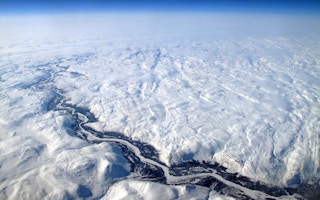With politicians failing to cut greenhouse gas emissions far and fast enough, the only hope may be to find a different way to cool the planet. One group of researchers has put forward an idea so different that critics may regard it as outlandish: heat the Arctic.
To heat the Arctic so much that the sea ice disappears even in the winter sounds like a weird idea. But the researchers believe it would have the beneficial effect of cooling the planet down.
They argue that with the Arctic ice already expected to disappear during the summer months within the next 30 years, and large increases in temperature and changes in the polar climate already certain, we should turn this radical shift to our advantage.
Their point is that since, at the current rate of progress, politicians seem unlikely to cut greenhouse gas emissions enough to prevent drastic temperature rise, humankind must find other ways to cool the Earth if it is to survive.
Heating the planet in order to cool it is certainly counter-intuitive. But, whether or not the scheme could ever work, it shows the ingenuity and enterprise now being poured into stabilising global temperatures close to their historic level.
It also, of course, shows how horribly late we have left it to rein in the climate crisis, when wise and determined action 30 years ago could have achieved so much.
“
Climate change is a major issue and all options should be considered when dealing with it.
Julian Hunt, postdoctoral research scholar, International Institute for Applied Systems Analysis
The idea proposed is, in principle, simple enough: to ensure that the warm currents of the Gulf Stream, known by science as the North Atlantic Oscillation (NAO) continue northwards across the Arctic Circle the whole year round. This would release massive amounts of heat from the ocean into the atmosphere and beyond that into space, so cooling the sea and ultimately the Earth.
“The Arctic Ocean ice cover works as a strong insulator, impeding the heat from the ocean below to warm up the atmosphere above. If this ice layer were however removed, the atmosphere would increase in temperature by around 20°C during the winter.
More heat escapes
“This increase in temperature would in turn increase the heat irradiated into space, thus cooling down the oceans,” explains the lead author of the study which details the proposal, published in the journal SN Applied Sciences. He is Julian Hunt, a postdoctoral research scholar at IIASA, the International Institute for Applied Systems Analysis.
The problem that needs to be overcome is that very cold and only mildly salty water currently floats on the surface of the Arctic Ocean, freezing in the winter and capturing the warmth of the water in the ocean depths.
The authors say the main factor helping to maintain the Arctic sea ice cover is the fact that the top 100 metres of the ocean is less saline than the Atlantic, preventing the Atlantic from flowing above the cold Arctic waters. Increasing the salinity of the Arctic Ocean’s surface, they say, would let the warmer and less salty North Atlantic current flow over it, warming the atmosphere considerably and releasing the ocean heat trapped under the ice.
They suggest three ways to keep fresh water out of the Arctic. The first would divert the big rivers of North America and Siberia southwards to prevent them draining into the polar ocean. The second would place submerged obstructions in front of the rapidly melting Greenland glaciers, to slow the speed of the ice sheets’ melting, while the third would use a solar- and wind-powered icebreaker to pump cold, near-fresh water deeper into the ocean to mix with the saltier water below, allowing the warmer currents to sweep in from the south.
Unknown consequences
Dr Hunt and his colleagues say there could be terrific benefits. Shipping could navigate the ice-free Arctic Ocean all year round, cutting journey times between Asia, Europe and North America. The need for heating homes in the northern hemisphere during the winter would be drastically reduced, because their plan would raise air temperatures by as much as 20°C.
But the massive interference with natural systems in the Arctic would also have its downside. The rapid year-round rise in temperature would dramatically increase the melting of Greenland and therefore of sea level rise the world over. The effect on the northern hemisphere climate, particularly much increased rainfall with a warmer sea and atmosphere, is impossible to predict.
But Dr Hunt says that while there are clearly huge risks, the world is already heading for uncharted waters, so humans must do something drastic. “Although it is important to mitigate the impacts from climate change with the reduction in CO2 emissions, we should also think of ways to adapt the world to the new climate conditions to avoid uncontrollable, unpredictable and destructive climate change resulting in socio-economic and environmental collapse.
“Climate change is a major issue and all options should be considered when dealing with it.”
This story was published with permission from Climate News Network.










